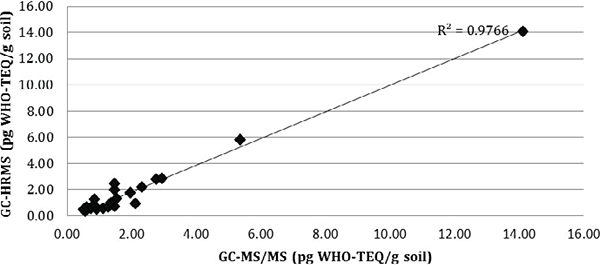Access Agilent eNewsletter February 2016

Agilent GC/MS/MS enables trace level analysis of dioxins in environmental samples
Craig Marvin, Agilent Environmental Industry Manager
The determination of polychlorinated dibenzo-p-dioxin (PCDD) and polychlorinated dibenzofuran (PCDF) congeners in environmental samples is complex and requires highly sensitive and selective instrumentation. At present, GC coupled to high-resolution MS (GC/HRMS) is described in conventional standard methods. GC/HRMS is the reference technique for accurate and specific PCDD/F determination, as in US EPA Method 1613. The current low-resolution MS method, EPA 8280, allows for the analysis of PCDD/Fs in soil, fly ash, sludge, and similar matrices at part-per-billion concentrations, but such levels are not in the range of environmental requirements. Regulations for soil, for example, are at part-per-trillion levels.
Recent studies have reported comparable results by GC/MS/MS and GC/HRMS in food and feed samples, suggesting their potential use for environmental samples. To assess the applicability of GC/MS/MS, we compared the two techniques to determine PCDD/Fs in low-level environmental samples.
GC/HRMS versus triple quadrupole GC/MS/MS
Twenty-two soil samples of 10 to 30 g were dried and spiked with 13C12-labelled surrogate 2,3,7,8-PCDD/F congener standards, extracted with organic solvents, and purified following EPA Method 1613. Five stack emission samples were tested and purified following European Air Method EN 1948. Purified samples were analyzed by GC/MS/MS and GC/HRMS. The GC/MS/MS method used an Agilent 7890 GC with an Agilent 7000C Triple Quadrupole GC/MS in positive electron ionization (EI) mode with multiple reaction monitoring (MRM) acquisition.
Quantification of each analyte was achieved using the isotopic dilution method. The limit of detection (LOD) was calculated individually for each sample based on a signal-to-noise ratio of 3:1. Concentrations were expressed as toxicity equivalents (TEQs) in terms of pg TEQ/g, calculated by multiplying the detected concentration by the corresponding toxic equivalent factors (TEFs). For the TEQ calculations, concentrations below the LOD were considered as half the LOD (middle-bound method).

Figure 1. Analysis of a low-level urban air sample (46 fg/m3 TEQ concentration) by GC/HRMS and GC/MS/MS shows similar results.

Figure 2. Good correlation between PCDD/F soil concentrations (expressed as WHO-TEQ) obtained by GC/MS/MS and GC/HRMS.

Figure 3. Good agreement: relative difference percentage (%) between the GC/MS/MS and GC/HRMS methods at various concentration ranges for PCDD/Fs.
Comparable selectivity
The selectivity provided by the GC/MS/MS technique was comparable to that of the high-resolution instrument. For example, Figure 1 shows the mass chromatograms of hexachlorodibenzodioxin congeners in an urban air sample, analyzed by both GC/MS/MS and GC/HRMS. This sample has a 46 fg/m3 TEQ concentration and represents a middle- to low-level urban environmental sample. The same congener peaks were clearly detectable by both approaches, with similar relative intensity. These results indicate similar specificity for environmental air sample analyses.
Figure 2 shows the correlation between PCDD/F soil concentrations (expressed as WHO-TEQ, the World Health Organization toxicity equivalent) obtained by GC/MS/MS and GC/HRMS. Despite the low PCDD/F concentrations, the results were in a good agreement, with an overall R2 correlation of approximately 0.97.
These correlations are concentration-dependent, as shown in Figure 3. The relative difference, expressed as |±?%|, between the two measurements in soil samples with lower PCDD/F concentrations (<1 pg WHO-TEQ/g) was 61%.
At PCDD/F concentrations above 1 pg WHO-TEQ/g, the average relative difference was as low as 4%, suggesting that in this range the Agilent 7000 Triple Quadrupole GC/MS was capable of quantitatively determining PCDD/Fs in environmental soil samples. This technique offers a realistic alternative approach to the classical GC/HRMS method, at least as a screening method.
Good agreement of results
The results of this study show good agreement between GC/MS/MS and GC/HRMS data for the analysis of soil samples that contain at least 1 pg WHO-TEQ/g (10 times lower than residential soil levels), as well as municipal solid waste (MSW) plant air emissions.
Outliers were observed for a limited number of congeners in the air emission samples, but these results never underestimated the true concentration. Based on our results, we suggest that GC/MS/MS methods can be used as screening techniques for PCDDs and PCDFs in environmental samples. As is the case with dioxin analysis in food and feed, this change would provide a larger number of analytical laboratories the ability to screen air emissions and environmental samples for PCDDs and PCDFs.
Full details of this work are available in Agilent publication 5991-5158EN.
Agilent environmental solutions for your analyses
Agilent offers many options for reliable and efficient environmental analysis and regulatory expertise. If you must ensure water cleanliness, measure air quality, or identify soil contaminants, our complete portfolio of mobile instruments, ICP-OES, MP-AES, GC/MS, LC/MS, sample preparation supplies, columns, and software solutions give you results you can trust.
Stay informed about the applications that are important to you
Subscribe to Access Agilent
Our free customized
monthly eNewsletter
Article Directory – February 2016
All articles in this issue
 New Agilent AdvanceBio SEC column simplifies mAb/ADC analysis
New Agilent AdvanceBio SEC column simplifies mAb/ADC analysis Support sustainability and maximize value for your labs by selling or buying used instrumentation
Support sustainability and maximize value for your labs by selling or buying used instrumentation Ask the Expert: Where can I go for expert advice on dissolution issues and techniques?
Ask the Expert: Where can I go for expert advice on dissolution issues and techniques? Agilent GC/MS/MS enables trace level analysis of dioxins in environmental samples
Agilent GC/MS/MS enables trace level analysis of dioxins in environmental samples Agilent Inert Flow Path for GC and GC/MS minimizes surface activity that compromises your results
Agilent Inert Flow Path for GC and GC/MS minimizes surface activity that compromises your results Tip: One call to Agilent ensures optimal performance of your PerkinElmer systems
Tip: One call to Agilent ensures optimal performance of your PerkinElmer systems Agilent AdvanceBio Peptide Mapping columns to solve glycan mapping challenges
Agilent AdvanceBio Peptide Mapping columns to solve glycan mapping challenges Agilent supports GC/MS with fast, accurate FTIR screening of phthalates in toys
Agilent supports GC/MS with fast, accurate FTIR screening of phthalates in toys Reduce carryover and enhance analysis speed with new Agilent 1290 Infinity II Vialsampler
Reduce carryover and enhance analysis speed with new Agilent 1290 Infinity II Vialsampler
Figure 1

Analysis of a low-level urban air sample (46 fg/m3 TEQ concentration) by GC/HRMS and GC/MS/MS shows similar results.
Figure 2

Good correlation between PCDD/F soil concentrations (expressed as WHO-TEQ) obtained by GC/MS/MS and GC/HRMS.
Figure 3

Good agreement: relative difference percentage (%) between the GC/MS/MS and GC/HRMS methods at various concentration ranges for PCDD/Fs.